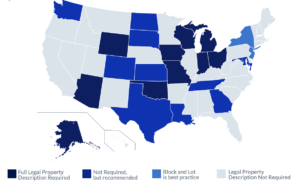
Going through the mechanics lien process on your own can be challenging. There are numerous requirements, notices, and deadlines that must be complied with. And that’s not all, gathering all the information required for preliminary notices and mechanics liens is particularly difficult. One thing contractors struggle with often is conducting a legal property description search. This guide will provide everything you need to know about legal property descriptions — and how to look them up.
What exactly is a legal property description?
A legal property description is a way of identifying property to ensure complete and legal accuracy. A mailing or street address does identify the location of a building, but streets can change names, land can be divided, and sometimes the address won’t even match the actual legal property description.
Learn more about property law with this guide to the top 4 things you should know.
So what exactly is a legal property description? Well, it depends on what part of the country you’re in. The US Government took land surveys ages ago, and used two basic methods to divide and identify land; metes and bounds, and lots and blocks.
Download our free Legal Property Description Cheat Sheet
Metes and bounds
Metes and bounds measurements are created by taking a point and measuring how long the distance is in any given direction. These are typically used in larger, more rural areas. Metes are the lines between each terminal point, or outermost points, of the property. While bounds are the more general boundaries of the property such as a public road or a waterway. A metes and bounds property description will generally look like this:
WYNDHAM HEIGHTS 158-5 B PARCEL F LESS:COMM NE COR PAR F W 406.83,S 302.98,W 93.50 TO POBS 208.13,W 247.80,N 166.10,NE 42.74,E 240.01 TO POB & LESS PT K/A CVS PROPERTY AS DESC IN OR 36186/389 & LESS ATLANTIC PROP. PER OR 36209/963 & LESS POR DESC IN OR 36309/1169 & LESS OR 41086/1447
If that makes little to no sense to you, you’re perfectly normal. To translate, this provides coordinates and then how far in what direction each of these coordinates goes to, which make up the full property.
Lots and blocks
The lots and blocks method tends to be used in more densely populated areas, these are based on a “plat system.” This is when city planners divided property into general shapes, such as rectangles, to control growth and provide access to utilities. The plat is the larger section of land, which is then broken down into blocks, which are further broken down into lots. A typical lots and blocks description will look something like the following:
PARCEL MAP AS PER BK 37 PG 76 OF P M LOT 2
This description provides which survey map to reference, the book and page number where it’s recorded, P M refers to the block, and the property is on lot 2. Simple, right?
Why should you care?
Well, there are currently around 11 states that explicitly require a full legal description of the property on a mechanics lien statement. Failure to properly identify the property could lead to costly delays and potential invalidation of the entire claim itself. But even if you aren’t working in one of these states, this is important to know nonetheless.
There are a number of states that require a “description of the property that is reasonably sufficient for identification.” In these types of states, a full legal property description isn’t required, but a simple street address won’t suffice. When in doubt, the more information you provide, the better. To help with this process, we’ve put together a map of all the states that require a legal property description to be included on a mechanics lien statement.
How to do a legal property description search
Conducting a legal property description search on your own can prove difficult, but not impossible. The best place to find a legal property description is to locate the deed. This is a legal document proving ownership of a particular piece of property. There are certain steps you can take on your own to locate the full legal property description.

Trying to find job information?
Learn more about job research at Levelset. We track down the property owner, GC, legal property description, and other hard-to-find information you need to file a lien or other documents.

County assessor’s office search
Most counties will have a copy of the deed filed in their county assessor’s office. Also, a majority of the county assessor websites, have a “property search” function, like the Orleans Parish Assessor, through which you can enter the municipal address, parcel number, or owner name to find the legal description. While most counties’ online resources are adequate in providing this information, there are some that are difficult to navigate, or that do not provide the necessary information.
The easiest way to find the “property research” is to go to the county assessor’s page and look for something along the lines of “parcel information” or “property research,” or simply Google search for the county name and assessor property search.
Once you have found the property research feature, simply select the criteria (owner, address, parcel number) you would like to search by. Generally, the most accurate results are obtained by searching by the parcel number (if you have it), because the county also uses this number to describe the property. This seems simple but there are two hurdles that may cause you some problems.
Problem 1: Nothing comes up by property owner name
If you search by owner and nothing comes up, this could mean that the person you believe to be the owner is in fact not the owner. This is common in commercial developments, as you may think the person that commissioned the work is the property owner, when they may in fact be a tenant or management company.
The same can happen on residential projects, as the lienor may list one person as the owner, but it is actually a married couple who owns the property. If nothing comes up when searching by the owner, try searching with the municipal address or the parcel number.
Problem 2: Nothing comes up by municipal address
Not finding a property description from a municipal address is more common than you may think. The addresses that buildings or houses are commonly known as may be recorded as something different with the county. This is common for businesses, as they may want an address that is easier to remember, or the business is part of a larger parcel and a different address is used to encompass multiple addresses.
This problem can also occur for residential projects. For instance, there is a home that goes by 11757 Moorpark Ave in Los Angeles County. However, while searching for this address, nothing was coming up. I was able to find out that the project is recorded under the municipal address of 11755 Moorpark Ave (see image). So while it may be commonly known as one address, the county has it recorded slightly differently.
Requests for information
If all else fails, you can always send a request for information to your hiring party, the general contractor, or even the owner themselves. In some states, the GC is required to provide this information if requested. In other states, there is a Notice of Commencement required on every project. These are either posted on the job site, provided to those who sent a preliminary notice, or are also available upon request. A Notice of Commencement will contain all the owner and property information necessary to file a mechanics lien.
Common mistakes with legal property descriptions
Mistake 1: Not including the full description
If you’ve read some other articles about lien filing on this website, you may have noticed that we frequently use the term full legal property description. That’s because these descriptions can get pretty lengthy, particularly metes and bounds descriptions. Forgetting to include the last measurement, or identifying a block, but not the lot contained therein will prove insufficient as a legal description.
Mistake 2: Subdivided property
Another common mistake is describing a tract of land that has been subdivided. This is particularly prevalent when dealing with new residential developments. When a property owner is looking to sell a portion of their land, there are legal procedures, zoning requirements, and other hurdles that need to be dealt with to properly subdivide the property. You may have correctly identified the larger tract of land, but in order to have an accurate legal property description, you’ll need to get more specific.
Mistake 3: Describing the wrong property
Let’s say you are a material supplier on a job. You’ve signed a contract, load up the truck and head over to the address given to you by the contractor. When filing your lien claim, you’ve identified the proper street address and managed to get the full legal property description. However, where you delivered materials might not be the same place as the property being improved. Many times claimants will describe a drop-off location, job site trailer, the GC’s office or shop, or any other offsite location.
Mistake 4: Including physical descriptions
This one seems a little silly, but you’d be surprised how often this comes up. There’s a reason we run an entire service based on helping with the process. Seemingly simple things can end up being much more difficult than anticipated. A “description” of the property doesn’t mean the property’s physical characteristics. If you start to write out something along the lines of “two-story brick home, with lumber framing and a detached two-car garage…” then you’re on the wrong idea train. Get off, and contact us.
How Levelset finds missing or incorrect project information
Our Levelset Scout Research team is an entire division dedicated to helping customers identify missing or conflicting property information and project stakeholders. Scout data pulls from nationwide property databases, county assessor records, Levelset’s internal database of millions of projects, and anywhere else they can find!
If all of this sounds way too confusing and/or complicated, we get it. Talk to one of our payment experts to see how we can help you.



